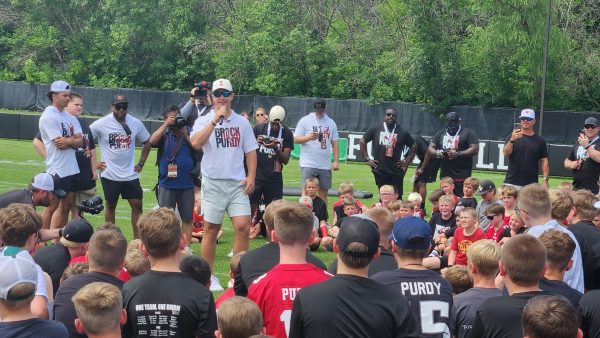Takeaways: A season defined by injuries and inconsistency
March 12, 2020
With the Iowa State men’s basketball team officially in the offseason and the rest of the sports world shutting down, it’s time to look back on a season that left much to be desired for Steve Prohm and the Cyclones.
The Cyclones’ season met its end Wednesday in a 72-71 loss to Oklahoma State in the first round of the Big 12 Tournament. The Cyclones ended their season 12-20 (5-13 Big 12), marking the first 20-loss season over the last two decades for the program.
In between record-setting blowout losses in Hilton Coliseum, a 0-11 record on the road and multiple injuries, Iowa State was dealt a season that had difficulties everywhere you looked.
Injuries leave Cyclones shorthanded
In terms of the poor hand Iowa State was dealt this season, Tyrese Haliburton’s season-ending wrist injury takes the cake as the biggest blow to the Cyclones’ season.
The projected lottery pick in the upcoming 2020 NBA Draft went down in Iowa State’s win over Kansas State on Feb. 8 after blocking a shot attempt from the Wildcats. He would leave to the locker room at halftime, but after the break, Haliburton emerged with his teammates and gave it a go to start the second half. Seven minutes in, Haliburton asked for Prohm to call timeout so he could be taken out of the game due to the pain getting so bad. Haliburton said days later that he couldn’t feel his fingers.
Two days later, Haliburton’s season was over after an MRI confirmed Haliburton broke his wrist, sidelining him for at least three months.
Haliburton’s season-ending wrist injury meant Iowa State would have move forward without his 15.2 points per game, along with a Big 12 leading 6.5 assists per game at the time of his injury.
The guard duo of sophomore Rasir Bolton and senior Prentiss Nixon took over in Haliburton’s place but couldn’t bring the same level of scoring and playmaking Haliburton had. Freshman guard Tre Jackson entered the starting lineup as well, but the freshman had lapses in his shooting and fouled out in multiple games.
The loss of Haliburton changed how Iowa State played at almost every level. Without Haliburton’s natural ability to facilitate to teammates and draw defenses away, Iowa State’s offense became stagnant and was waiting to find a solution to replace Haliburton at the point. Defenses would start to pressure Bolton and take away most of his driving lanes to stop him from making it to the free-throw line.
Multiple lineup changes and minutes reductions and increases took place in the weeks after Haliburton went down, with Prohm and his staff searching for an answer to the injured lineup.
And with Nixon being far less effective on offense than both Haliburton and Bolton, ending his season shooting 26.3 percent from three, the late in-season loss of Bolton would make life for Iowa State even worse over the final pair of games.
In Iowa State’s 77-71 loss to West Virginia, Iowa State would be dealt another major blow to its already limited lineup.
After a hard fall after drawing contact at the rim against the Mountaineers, Bolton would be evaluated days later for a concussion, but Prohm told the media March 5 that Bolton didn’t have a concussion.
Two days later, Bolton didn’t even dress for Iowa State’s regular season finale against Kansas State with concussion-like symptoms. Freshman Caleb Grill was thrust into the lineup and shot 1-7 from three in a team-leading 38 minutes of play. But Bolton’s absence wouldn’t be the last for the Cyclones, even with just two games left.
Nixon also ended up falling after drawing hard contact on a layup attempt and injuring his left ankle. He didn’t return, and walk-on Nate Jenkins had to step in and play the final nine minutes.
Without Bolton and Nixon, Iowa State ended its regular season with a loss to the worst team in the Big 12.
Inconsistent play from key contributors
With Haliburton’s injury, pretty much everyone needed to expect an increased role. Iowa State didn’t have much consistency in the wake of Haliburton’s absence, and instead, many key players would have long stretches of poor play, only to find their spark for a game or two.
For example, Nixon went over a month during the season without scoring in double figures, but he lit up the box score with a rare hot shooting night, including the season finale in the first round in the of the Big 12 Tournament on Wednesday.
Nixon showed out in his final game, scoring a career-high 25 points on 11-21 shooting after he combined for 35 points in his three previous games.
The lack of consistency wasn’t just in the Colorado State transfer, as the backcourt for Iowa State struggled to establish itself as a formidable post-presence all season.
Michael Jacobson struggled for most of his senior season. The redshirt senior went from Dec. 22 through Feb. 12 scoring in double figures twice. Jacobson struggled from the free-throw line and lacked the shot-blocking ability that George Conditt showed in the beginning of the season.
Conditt struggled after a hot start to his sophomore campaign in which he scored six times in double figures and averaged 2.7 blocks a game before he entered the starting lineup Jan. 12. After Jan. 12, Conditt didn’t reach double figures for the final 18 games of the year.

















